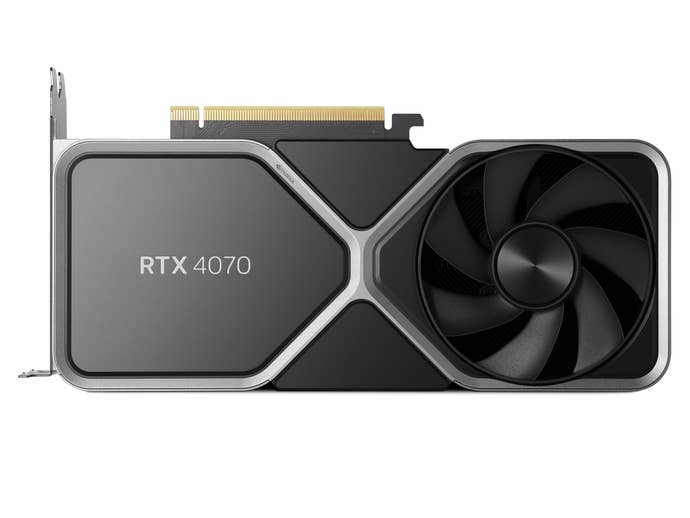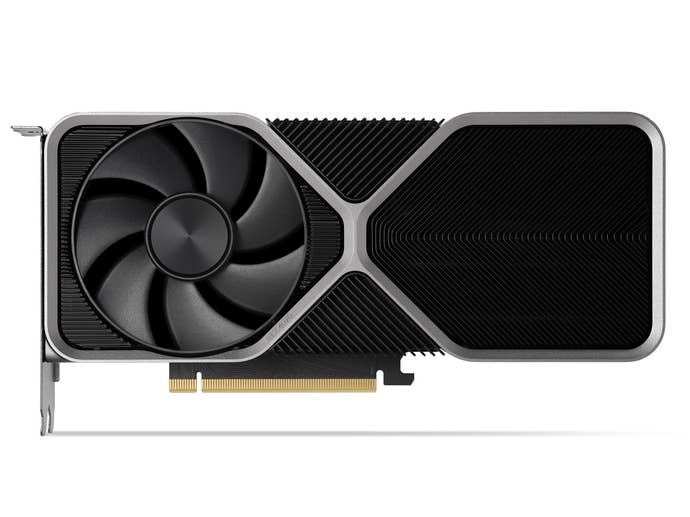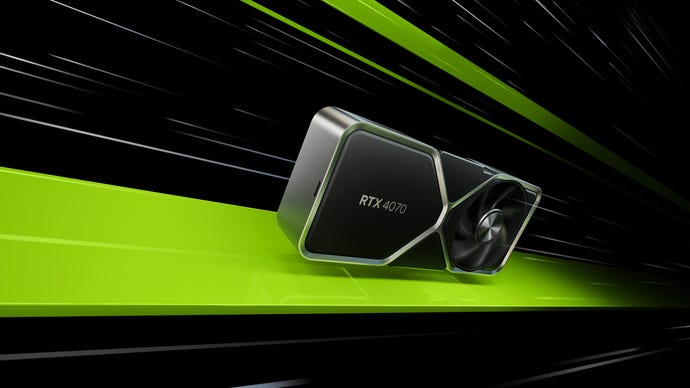Nvidia GeForce RTX 4070 review: heir to the 3080, and a more reasonable new-gen entry point
Nvidia's latest 40 series GPU is also its cheapest yet. More affordability doesn't mean this isn't powerful, though - it is. But does it justify the cost?
The range of Nvidia 40 series GPUs expands this week with the addition of the GeForce RTX 4070 – the most affordable card in the range that nevertheless brings with it some major bonuses as an upgrade on previous generations. But how well does it stack up, and how good a value is it? We’re here to find out.
Out in the real world we’re in the middle of a wild inflationary bonanza, and it’s impossible to responsibly review these hugely decadent pieces of wonderful gaming hardware without at least considering where it might slot into people’s budgets. So let’s start there, with the 4070’s role as the current cheapest entry point into Nvidia’s hot new 40-series GPUs.
At $599/£589, the 4070 is still undoubtedly expensive. It continues a trend with the 40 series which places them as priced perhaps a little too bullishly for what might make them ‘must-have’ cards. Lop $50 off this price and it becomes extremely attractive; drop it by a round $100 and it becomes an absolute must-have. As it stands, it’s tempting, and does broadly justify its price-point – especially when taking into account the price structure of the complete range. But I do wish it were lower.
As discussed before with these cards, much depends on exactly where you place your priorities. How, exactly, do you measure the bang-for-buck of these cards? Traditionally, you’d do this by looking at the frame rates you can achieve against the price you pay, compared to other available options from both Nvidia and its rivals like AMD. Now, however, the waters are muddied. Many new features that significantly change the gaming experience like Reflex and DLSS, and their equivalents from other companies, are major components of the decision-making process.
In the grander pantheon of things, the RTX 4070 shoots to match the performance of last generation’s RTX 3080. The 3080 launched a little over two and a half years ago at $699; so for $100 less, you now get broadly the same level of performance as that card out of the gate. In addition, you’ve got the advantages of being on the 40-series Ada Lovelace architecture, which unlocks DLSS 3.
The most interesting advantage is the difference in power consumption between the two, however. Ada is massively more efficient than its predecessor Ampere – and as a result if you put the two head-to-head in the same games, you’ll see similar in-game performance but see the 3070 draw in excess of 50% more power than the 4070. That’s a key component of this generational leap; a drop in power consumption. That, of course, brings us back to that state-of-the-world factor. With electricity bills high, that’s a decent advantage for the newer card, if you can afford the initial outlay.

So. Let’s talk about those frame rates. To be clear, this is not primarily intended as a card for 4K resolution. The sweet spot here is 1440p and below, which is more than serviceable at this price point. Chances are that if you’ve got the dosh for a big ol’ 4K PC display, you’re also willing to drop a grand on a GPU like the 4090 or 4080.
At lower resolutions, the 4070 performance is quite tidy, and is obviously where Nvidia sees the card in the market. To reflect this, the benchmarks presented in brief here are at 1440p, with settings generally maxed out. Meanwhile, if you choose to get this card and crank for 4K, you’ll still get decent results – but our advice would be to save a bit longer and go for one of the cards designed as a 4K beast.
Forza is a benchmark classic for us on VG247, and Forza Horizon 5 paints a pretty clear picture of where the 4070 sits in the grand scheme. With identical settings, the 4070 enjoyed a modest 10% increase over the 3080, enjoying a frame rate slightly over 120fps. This was without the new implementation of DLSS 3 enabled (which lets you push things further). Hop on over to Hitman 3, another regular benchmark, and we see the 4070 and 3080 neck-and-neck in offering an experience that’s just shy of 60fps with all the ray tracing bells and whistles enabled.
It’s not always a match, however. If we head to Metro Exodus we can see the 3080 taking a minor lead, though it is a very close-fought affair, with post cards managing a smooth 60 well enough. Control is a game that really presses GPUs with ray tracing enabled, and in that game we see the 3080 actually take the lead.
Do you notice the theme here? Nvidia’s stated goal was to match the 3080… and the 4070 does just that. It does what they’ve claimed. This has a curious result: I wouldn’t recommend the 4070 as an upgrade for any owner of a 30-series card. The leap just isn’t large enough. However, if you have anything from a generation older than that (the 20 series and under), this is suddenly the most affordable card, with absolutely tremendous uplift.
Returning to Hitman, for instance, on pretty much any 20-series card except the very top tier you can jump from languishing around or under 30fps up to a near-solid 60fps on the 4070. Metro is a similar story, from the low 40s up to the mid-70s. The single-generation leap isn’t major then, but the leap across two generations is notable. If you want to make an external comparison, the 4070 also wipes the floor with any of the current-generation consoles . It’s not even a contest.

And what about versus Nvidia’s sworn rival AMD? As it stands right now, AMD hasn’t released a current-generation card in this price bracket. This will therefore likely be a major battleground in the coming year. It is worth noting, however, that discounted AMD Radeon 6950 XT cards can be had for just a little more than the 4070 if you shop around. In this debate, however, Nvidia’s X-factor remains its software and other features. Though AMD has versions of Nvidia’s Broadcast, DLSS, and Reflex, Nvidia is undoubtedly the market leader for those sorts of features.
DLSS in particular is a game changer, and with DLSS 3 exclusive to the 40-series cards, the 4070 is now the easiest way to make the jump. If you have the choice between a discounted 3080 (which seems unlikely; they’ve held their price well) and a 4070, this should be the deciding factor. DLSS 3 will be used by more games going forward, is huge in the few games it supports right now, and is worth the extra investment.
We don’t have a crystal ball for AMD’s future products either, and so as it stands now for anyone on older generation cards who is beginning to feel the squeeze of their age the 4070 feels like a compelling upgrade, and the most immediately affordable.
Nvidia has released a couple of products in recent years where they present as hair-raising leaps forwards. The 4070 is not that. What’s offered instead is a belt-and-braces card that matches a higher-tier product from the previous generation at a lower price and higher efficiency. It’s the closest thing to a mid-tier 40-series card, and a strong entry point to the generation. That works for us, and it should become a staple card of this hardware gen. I just wish that prices were a little lower across the board.


